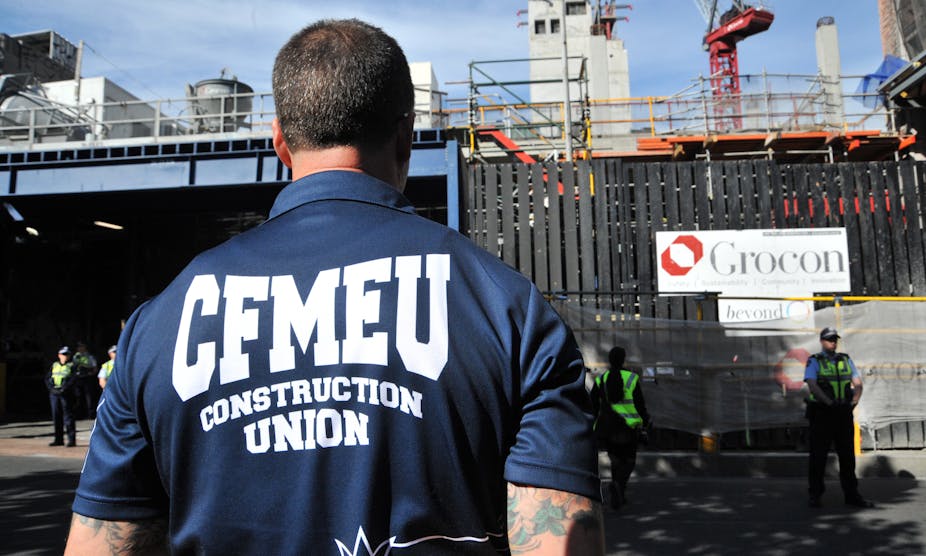As allegations of corruption in Australia’s construction unions continue to emerge, the scandal – purportedly involving underworld heavyweight Mick Gatto and bikie gangs – appears to be an Underbelly script waiting to happen.
Union official Dave Noonan discussed the corruption scandal in terms of the industry’s “rotten apples”. This is a dangerous analogy to use. Not only does it suggest that successful reform lies in picking out the few corrupt officials, it fails to address how and why corruption has taken root.
With widespread allegations of corruption within the building unions involving accepted practices of extortion, death threats and collusion with organised crime, it is the systems and practices that have allowed this conduct to occur and continue – the rotten barrel – that must be addressed, not the rotten apples.
Increasingly, however, the media reports of corruption in the building industry are being framed in terms of how it can be fixed. Much attention has been given to the royal commission versus taskforce debate. Both sides have their merits: taskforces are generally cheaper and less time-consuming, whereas royal commissions are usually granted greater scope and investigative powers.
Focusing on how to fix the rotten barrel is both a positive and practical way of approaching the issue. The risk in taking this approach is that the issue becomes politicised. Scrutiny of the causes and true nature of corruption in the building industry risks being lessened in favour of focusing on the political role of unions.
We need to take the politics out of reform for it to be successful. This is difficult, but not impossible.
A number of royal commissions have been conducted into corrupt organisational cultures, most of which have met with varying success. Three prominent examples of successful commissions have examined the causes, not the politics, of corruption. These are:
- The 1972 Knapp Commission into corruption in the New York Police Department (NYPD);
- The 1973 inquiry in the Hong Kong police into corruption;
- The 1997 Royal Commission into corruption in the New South Wales police force.
These three reform inquiries investigated police corruption, not corruption in the building industry. However, similarities can be drawn between the current nature of corruption in Australia’s building unions and police corruption. Collusion with organised crime has appeared in both cases, and so too has the political influence of the bodies being investigated.
Further, with investigations into police corruption occurring at different points in history – and in different parts of the world – these provide a window through which successful outcomes can be evaluated.
The 1972 Knapp Commission into corruption in the NYPD focused on reform over politics. In fact, it was in the findings of this commission that the terms “rotten apple” and “rotten barrel” were first used in discussing anti-corruption reform. Similar to the current corruption scandal in Australia’s building unions, the true extent of malpractice in the NYPD only became apparent following the revelations made by a whistleblower, Detective Frank Serpico.

As a result of Serpico’s testimony and investigations conducted by the Knapp Commission, it was determined that the established practices of corruption were best addressed by examining and understanding what caused the barrel to rot, and that the rotten apple theory was not conducive to effective organisational reform.
A similar approach was taken by the 1973 Hong Kong police inquiry. Not only did this royal commission tackle widespread corruption within a popular and powerful agency, it did so from the viewpoint of wanting to reduce levels of corruption, not from an anti-police platform.
Further to this, a number of steps were taken to understand how and why corruption was able to reach such endemic levels within the Hong Kong police. The rotten barrel was addressed, while the rotten apples were reprimanded.
This understanding of corruption was also applied to the 1997 Royal Commission in NSW, in which the organisational culture and practices of the police force were interrogated. This interrogation was done at the same time as policies and laws were drafted to prevent individual officers from engaging in corruption. Here, the barrel was targeted without ignoring the apple.
While the extent of corruption in the building industry still remains unknown (and will stay so until any inquiry begins), the depth of these organisational practices needs to be questioned. The first expose of corruption in Australia’s building industry occurred in 1993. Since then 21 years have passed and very little has been done.
It was 20 years before that inquiry that Hong Kong undertook anti-corruption reform. There is now four decades of organisational anti-corruption knowledge and experience that can be applied to tackling corruption in Australia’s building industry.
Politics can be removed from reform without challenging its success. The unions were born from a desire to protect the worker, and there are workers who still need to be protected, just as there are undoubtedly unions that are not corrupt. What is happening in this case is corruption, misconduct and collusion with organised crime. This is a symptom of a rotten barrel, not a rotten movement.
For this issue to be adequately addressed, reform needs to examine the systems and processes that have allowed these practices to occur. But let’s not wait another 21 years.

